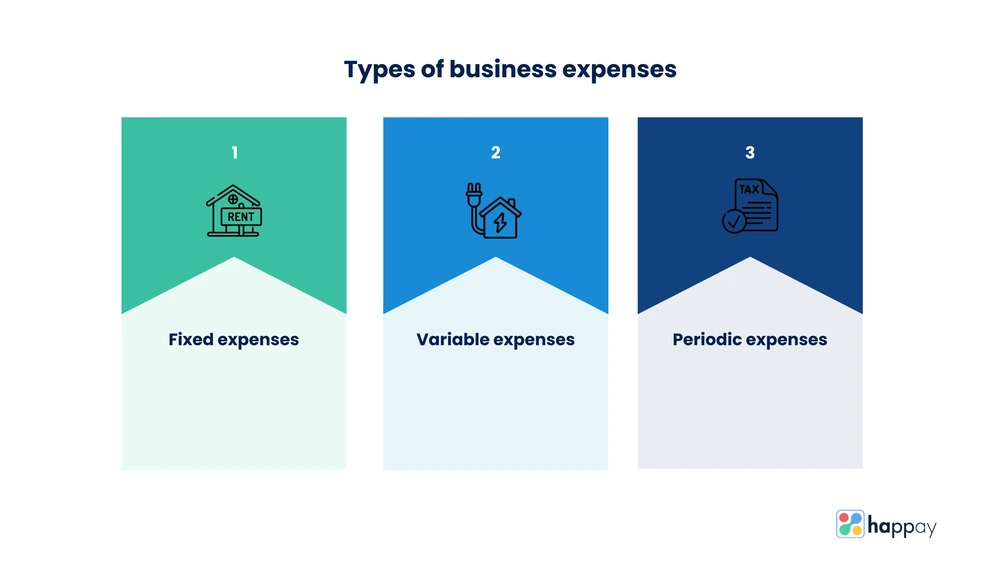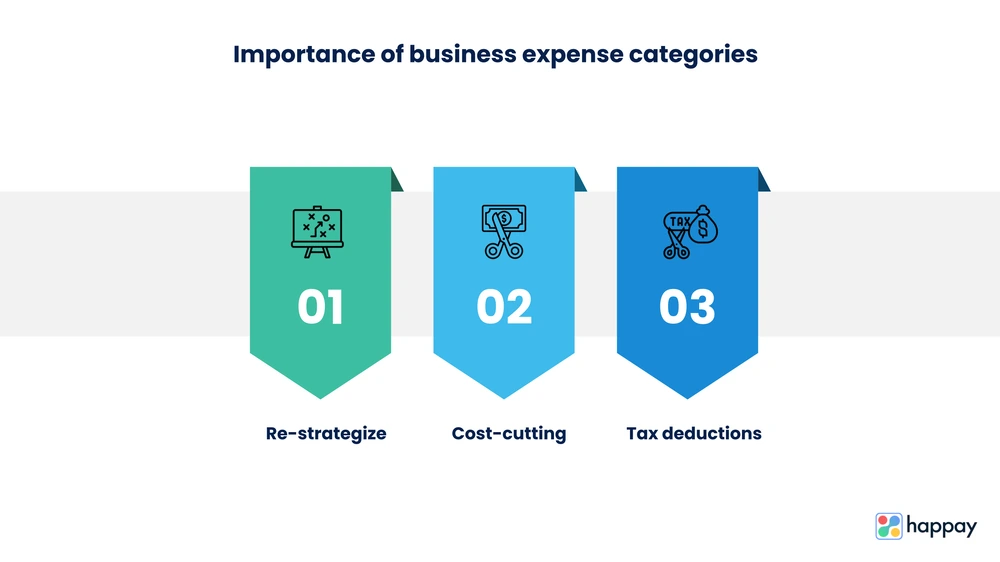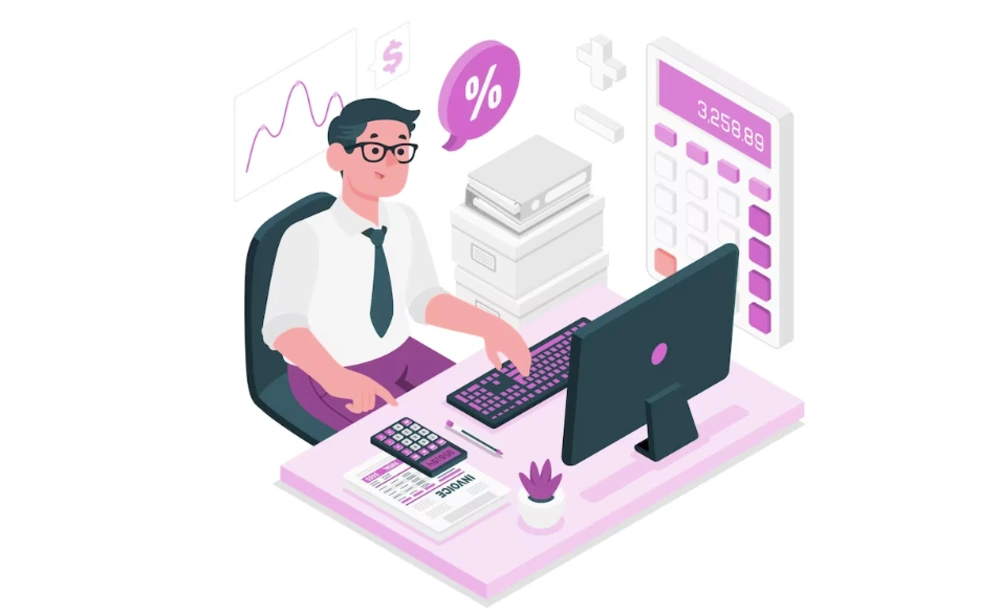Last Updated on November 28, 2025
Business expense categories
Running a company can feel like a constant juggling act. You have customers to satisfy, meet deadlines, and manage finances. And when it comes to expenses, it can become easy to lose track of where your money is going. But did you know that correctly categorizing your expenses can affect your organization during tax time?
Tracking and classifying your expenses will help you take advantage of all the deductions available to your business. That’s why we’ve compiled a list of 20 business expense categories you need to consider for your company.
But we’re not stopping there. We will also provide guidance to track your expenses and set up custom categories that work for your unique business.
So, let’s dive in and look at the business expense categories list.
Also, Read: Capital Expenditure (CapEX) Meaning
What are business expenses categories?
Business expense categories refer to expenses an organization incurs during its business operations. It is essential to categorize expenses as the exercise can help your business keep track of its spending and make informed decisions about finances. It can also help your business report its expenses for tax purposes, ensuring you take advantage of all the available deductions.
Some common items in a business expense categories list include:
- Office supplies
- Office space rent
- Salaries and wages
- Advertising and social media campaigns
- Business travel expenses
- Subscriptions
Proper categorization of expenses helps ensure you track your spending accurately and efficiently. You can also identify areas where you may need to spend more wisely and adjust your budget accordingly. Furthermore, you can identify expenses eligible for tax deductions, which can help save money in the long run.
Also, Read: What is Spend Managment?
What is a tax-deductible business expense?
A tax-deductible business expense is an expense that remains deductible from your taxable income. It helps reduce the amount of taxes you owe. For example, if your startup business earned INR 10,00,000 in revenue but had INR 1,00,000 in tax-deductible business expenses, your taxable income would only be INR 9,00,000.
Now, you may wonder, what types of expenses are tax-deductible? Any expense that is ordinary and necessary for the operation of the business can be tax-deductible. This can include expenses like rent, payroll taxes, and more.
Let’s say you attend a trade show to advertise your startup business’s new product launch. You can deduct the cost of your travel, lodging, and meals associated with that trip.
However, it is important to know that not all expenses are tax-deductible, and there are limits to what can be deducted. For example, there are limits on how much you can deduct for meals and entertainment expenses. Also, certain expenses may only be partially deductible.
Types of business expenses
Here are the three types of business expenses you should be aware of when budgeting and managing your finances.

1. Fixed expenses
They remain constant and do not change regardless of the level of production or sales. Examples of fixed expenses include rent or lease payments, salaries, insurance premiums, and property taxes.
2. Variable expenses
They fluctuate based on the level of production or sales. Examples of variable expenses include the cost of raw materials, utilities, and sales commissions.
3. Periodic expenses
They occur on a less frequent basis, such as quarterly or annually. Examples of periodic expenses include taxes, licence and permit fees, and equipment maintenance costs.
Quick Read: Expense vs Expenditure
Importance of business expense categories
Business expense categories list helps you track where your money is going and how much you’re spending in different areas. It can also help you identify trends and patterns, which can be useful in making financial decisions.
Here are 3 reasons why every finance leader needs a business expense category list.

1. Re-strategize
As a CFO, you may spend more money on advertising than expected. In that case, you can evaluate the effectiveness of your marketing campaigns and adjust your strategy accordingly.
2. Cost-cutting
Proper categorization of expenses helps identify areas where you can cut costs. You may discover you’re spending more money on a particular expense category than necessary. For instance, you may find that you’re paying more for supplies than you need to or that you can negotiate a better deal with a vendor.
3. Tax deductions
Keeping accurate records of your expenses and categorizing them correctly will help you take advantage of tax deductions. You can deduct some of your home office expenses if your business has a remote setup. These include rent or mortgage interest, property taxes, and utilities.
Recommended Read: Operating Expenses and Non-operating Expenses
20 Business expense categories list:
Here is a common business expense categories list of 20 items you should consider for your startup, small business, or established corporation:
1. Advertising and marketing
These expenses include all costs of promoting your company, like online ads, billboards, and print advertisements.
2. Website and software expenses
Expenses associated with maintaining your company website and purchasing software for your business, like accounting software or graphic design software.
3. Entertainment
This category includes expenses related to entertaining clients or customers, such as tickets to sporting events, meals, or drinks.
4. Business meals and travel expenses
These expenses include the cost of meals and transportation when traveling for business purposes.
5. Rent or mortgage payments
The cost of rent or mortgage payments.
6. Home office costs
These expenses include the cost of maintaining a home office, such as rent, utilities, and equipment.
7. Utilities
This category includes expenses for keeping your company running, like electricity, water, and internet.
8. Furniture, equipment, and machinery
This category includes expenses related to purchasing or leasing furniture, equipment, and machinery for your organization.
9. Office supplies
Expenses associated with purchasing office furniture and supplies, like paper, ink, and pens.
10. Vehicle expenses
These expenses include the cost of owning or leasing a vehicle for company purposes, like fuel, maintenance, and insurance.
11. Payroll
Expenses associated with paying your employees, like salaries, wages, and bonuses.
12. Employee benefits
Benefits provided to employees, such as health insurance and retirement plans.
13. Taxes
All business taxes, including income taxes, property taxes, and sales taxes.
14. Business insurance
Expenses related to company insurance include liability insurance, property insurance, and workers’ compensation insurance.
15. Business licenses and permits
Costs associated with obtaining and renewing business licenses and permits.
16. Interest payments and bank fees
Interest payments on business loans, bank accounts, and credit card fees.
17. Membership fees
Membership fees for professional organizations or trade associations.
18. Professional fees and business services
Expenses associated with hiring professionals to provide services to your company, such as legal or accounting services.
19. Training and education
Expenses related to training and education for you and your employees.
20. Depreciation
The loss in value of business assets, such as equipment or machinery, over time.
Understanding these categories and accurately tracking your expenses will help you manage your cash flow, identify areas for cost savings, and maximize tax deductions.
Also, Read: What are selling expenses?
Best practices to set up business expense categories
Here are some best practices that finance officials must consider when setting up a business expense categories list.
1. Keep it simple
A complicated expense category system can confuse and overwhelm employees, resulting in errors and inconsistencies in expense tracking. Keep it simple by creating broad and easy-to-understand categories.
2. Be specific
While keeping it simple is important, it’s also essential to be specific when categorizing expenses. Create categories relevant to your business and its expenses, and make sure they are detailed enough to distinguish between different types of expenses.
For example, instead of just having a general category for travel, you can have separate categories for airfare, hotel accommodations, transportation, etc.
3. Use a consistent naming convention
Establishing a consistent naming convention will ensure everyone is on the same page. Use clear and concise names for categories that are easy to understand and remember.
4. Group similar expenses
Grouping similar expenses will help identify patterns and trends in your spending. For example, you can group office supply expenses into one category. Alternatively, you can categorize your marketing expenses in another category.
5. Use subcategories
In addition to creating broad categories, consider using subcategories to classify expenses further. For example, you can have a category for meals and entertainment and create subcategories for client meals, employee meals, and entertainment expenses.
6. Review and update regularly
Your company expenses will evolve over time. It is thus crucial to review and update your expense categories regularly to ensure they are still relevant and useful. Take the time to analyze your spending patterns and adjust your categories as needed.
Also, Read: SG&A Selling, General and Administrative Expenses
How to set up business expense categories?
You can set up a business expense categories list with the help of the following tools:
- Expense tracking tool
It is an excellent on-the-go solution that integrates with your accounting software. Setting up business expense categories with an expense management tool can help you keep track of your expenses and make it easier to file taxes.
- Accounting software
Setting up business expense categories with accounting software can help you streamline your finances and ensure accurate bookkeeping.
- Corporate credit card
Setting up business expense categories with a corporate credit card is convenient for large enterprises. Corporate credit cards help you track expenses and manage your budget more effectively.
Let’s look at a step-by-step account of setting up business expense categories, irrespective of whether you use an expense tracking tool, accounting software, or a corporate credit card.
Follow these steps to categorize your expenses with the expense tracking tool.
1. Create a new expense category
2. Name the category
3. Define the category type
4. Assign a tax code
5. Set a budget limit
6. Save the category
7. Repeat for all categories
8. Assign expenses to categories
9. Review your expense reports
Suggested Read: 5 Best Corporate Credit Cards in India
Tips to maximize tax deduction through expense categorization
Proper expense categorization is crucial for maximizing tax deductions for your business. Here are some tips to categorize your expenses correctly and maximize tax deductions.
1. Understand what is deductible
Familiarize yourself with tax-deductible business expenses. Usually, expenses that are necessary and ordinary for your business are deductible.
Examples of tax-deductible business expenses include rent, office supplies, travel expenses, and advertising costs. On the other hand, personal expenses not directly related to your company are generally non-deductible.
2. Use a detailed expense tracking tool
Use a detailed expense tracking tool to categorize expenses by type and assign them to specific accounts. This will make it easier to identify and categorize deductible expenses.
3. Categorize expenses accurately
Ensure each expense is accurately categorized based on its type and the specific account it should be assigned to. It will help you identify and separate tax-deductible business expense lists from non-deductible ones.
4. Keep receipts
Keep all receipts and documentation for business expenses, even for small purchases. It will support your deductions in case of business audits.
5. Consult a tax advisor
Consulting a tax advisor will ensure you correctly categorize your expenses and maximize your deductions. They can help you identify any overlooked deductions and ensure your expense categorization complies with relevant regulations.
6. Monitor and review expense reports
Regularly monitor and review your expense reports to ensure each expense is categorized correctly. Make necessary changes to ensure you take advantage of all available deductions.
Also, Read: What are Incidental Expenses?
Establish robust business expense categories lists and maximize tax deduction today with Happay
Happay helps organizations establish robust business expense category lists and comprehensively maximize tax deductions. To begin with, Happay offers corporate credit cards that can be assigned to employees for business-related expenses.
The cards can be customized with spending limits, category restrictions, and other controls to ensure that expenses are allocated to the correct categories.
You can create expense categories customized to fit your specific business needs. Furthermore, you can easily add new categories, map them to your accounting system, and allocate expenses to the correct categories.
Happay integrates seamlessly with various accounting and ERP systems that help you import expense data into your accounting system. It ensures expenses are accurately recorded and allocated to the correct categories.
You also get real-time visibility into business expenses, allowing you to track expenses as they occur. You can monitor spending trends, identify overspending, and make necessary adjustments to maximize your tax deductions.
Bottom line
Categorizing business expenses will help you in managing your business’s finances effectively. Furthermore, a business expense categories list will help you gain insights into your spending patterns, identify areas for cost-saving, and maximize your tax deductions.
Categorizing expenses accurately and separating deductible and non-deductible expenses will allow you to reduce your tax liability and keep more of your hard-earned money.
It is essential to remember that the IRS requires accurate and detailed records of business expenses, and failing to categorize expenses properly could result in penalties or audits.
Ensure you utilize the right tools like a corporate credit card or expense tracking software. Remember also to follow the best practices for expense categorization that will simplify the process and help you gain valuable insights into your business’s financial health.
FAQs
Business expenses can be categorized based on office expenses, travel expenses, utilities, rent, salaries, equipment, advertising, and others. The categories will depend on the nature of the business and the expenses incurred.
Categorizing expenses can help you keep track of your spending, identify areas for cost-cutting, create accurate financial statements, and make informed decisions about future expenditures. Grouping similar expenses helps you see where your money is going and how to improve your bottom line.
Examples of business expenses include office supplies, travel expenses, rent, salaries and wages, and equipment purchases. Other examples include advertising and marketing costs, utilities, insurance premiums, and taxes.
The three categories of expenses are fixed, variable, and periodic expenses. Fixed expenses remain the same regardless of the volume of business, while variable expenses change based on business activity. Periodic expenses occur at fixed intervals of time.
Ordinary and necessary expenses for conducting business qualify in the tax-deductible business expenses list. A general tax-deductible business expense list may include rent, utilities, wages, taxes, insurance, supplies, and business-related travel expenses.
Yes, you can write off meals and entertainment expenses. However, the amount can vary based on the applicable regulations. The expenses must be directly related to conducting business, and documentation is required to prove the expenses were incurred for a legitimate business purpose.
Businesses can track their expenses and receipts by using accounting software and spreadsheets. It is important to keep all receipts and document the business purpose of each expense to ensure accurate tracking and reporting.
Businesses can consult with their tax professional or refer to relevant guidelines to determine if a particular expense is deductible. The eligibility of a business expense may depend on the nature of the expense and how it relates to the business.
Expenses that are ordinary and necessary for conducting business can be shown to save tax in business. Examples include office supplies, rent, utilities, etc.
The four most common tax deductions for businesses include expenses for business use of a vehicle, travel expenses, office expenses, and depreciation of assets. Other common deductions include expenses for professional services, insurance premiums, and employee benefits.










Discussion about this post